technology
Getting the most out of air and energy to achieve clean surfaces, drinkable water, clear skin and more – that’s our cold plasma technology in practice.
Learn about the difference between plasma and cold plasma, the power of reactive species, the full circularity of our cold plasma generation process, and its many aspects of sustainability.
plasma
almost everything visible in the universe...
Plasma is superheated matter – so hot that the electrons are ripped out of the atoms and form an ionized gas. It makes up over 99% of the visible universe.
In the night sky, plasma glows in the form of stars, nebulae and even the northern lights, which can sometimes be seen over the North and South Poles. The lightning that tears up the sky is plasma, as are the neon signs on our streets. And so is our sun, the star that makes life on earth possible.
the fourth state of matter
Plasma is often referred to as the “fourth state of matter,” alongside solid, liquid and gaseous. Just as a liquid boils and turns into a gas when energy is added, heating a gas creates a plasma – a soup of positively charged particles (ions) and negatively charged particles (electrons).
Because so much of the universe is made up of plasma, its behavior and properties are of great interest to scientists in many disciplines.
cold plasma
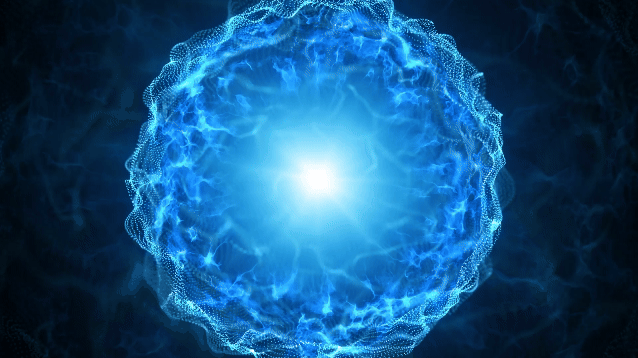
...is plasma “light”
What happens if you add very little energy to a gas – compared to plasma, let’s say you only ionize every billionth particle? That’s right – you get cold atmospheric plasma or cold plasma.
Unlike hot plasma, it does not require extreme heat, making it safe to use in temperature-sensitive applications. It consists of a mixture of ions, electrons, neutral atoms and reactive substances such as ozone or nitrogen oxides.
Cold plasma, also known as non-thermal plasma, is a partially ionized gas in which only a fraction of the particles are ionized, allowing it to operate at near room temperature.
(Hot) plasma
Cold Plasma
do your products need an innovation boost?
Cold plasma and its diverse application potential also offers your company sustainable and at the same time economically attractive differentiation opportunities to break new ground and successfully set yourself apart from your competitors.
Talk to us about the many possibilities offered by cold plasma.
components
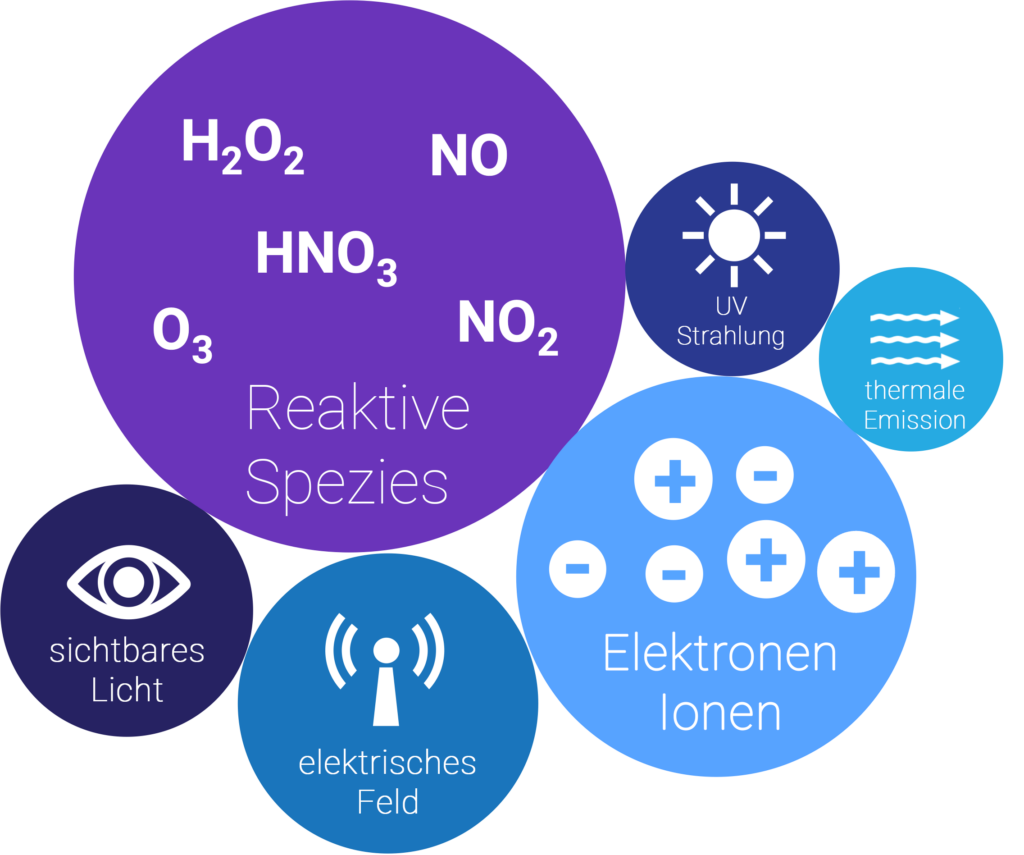
what is cold plasma made of?
Cold plasma is a partially ionized gas consisting of a variety of charged and neutral particles. It contains so-called reactive species (RONS – Reactive Oxygen and Nitrogen Species), which make up the majority of the payload of cold plasma. These “active substances” include reactive oxygen (ROS) and nitrogen species (RNS), such as ozone (O₃), hydrogen peroxide (H₂O₂), nitrogen monoxide (NO) and hydroxyl radicals (OH). These species have a strong disinfectant effect and play a crucial role in plasma medicine and water and air purification.
Electrons are accelerated by electric fields and collide with neutral gas atoms, causing ionization, dissociation and excitation to occur. Ions formed in plasma can also drive chemical reactions, particularly in modifying the surface of materials or killing microorganisms. Due to the different temperatures of the electrons and heavy particles, there is only a small amount of heat generated in the plasma. In cold plasma, the total energy always remains low enough to avoid thermal damage to living tissue.
Cold plasma also produces some ultraviolet radiation (UV), which can contribute to sterilization. This radiation also works synergistically with the reactive species to destroy microorganisms. High-frequency electric fields keep the cold plasma stable and control ionization. These fields influence charged particles in the plasma and can be used specifically for material processing or cell stimulation.
Cold plasma also often emits visible light, which can appear in different colors depending on the gases used. These luminous phenomena arise from the recombination of electrons with ions or from the transition of excited atoms to a lower energy level.
how it works
cold plasma - circular by nature
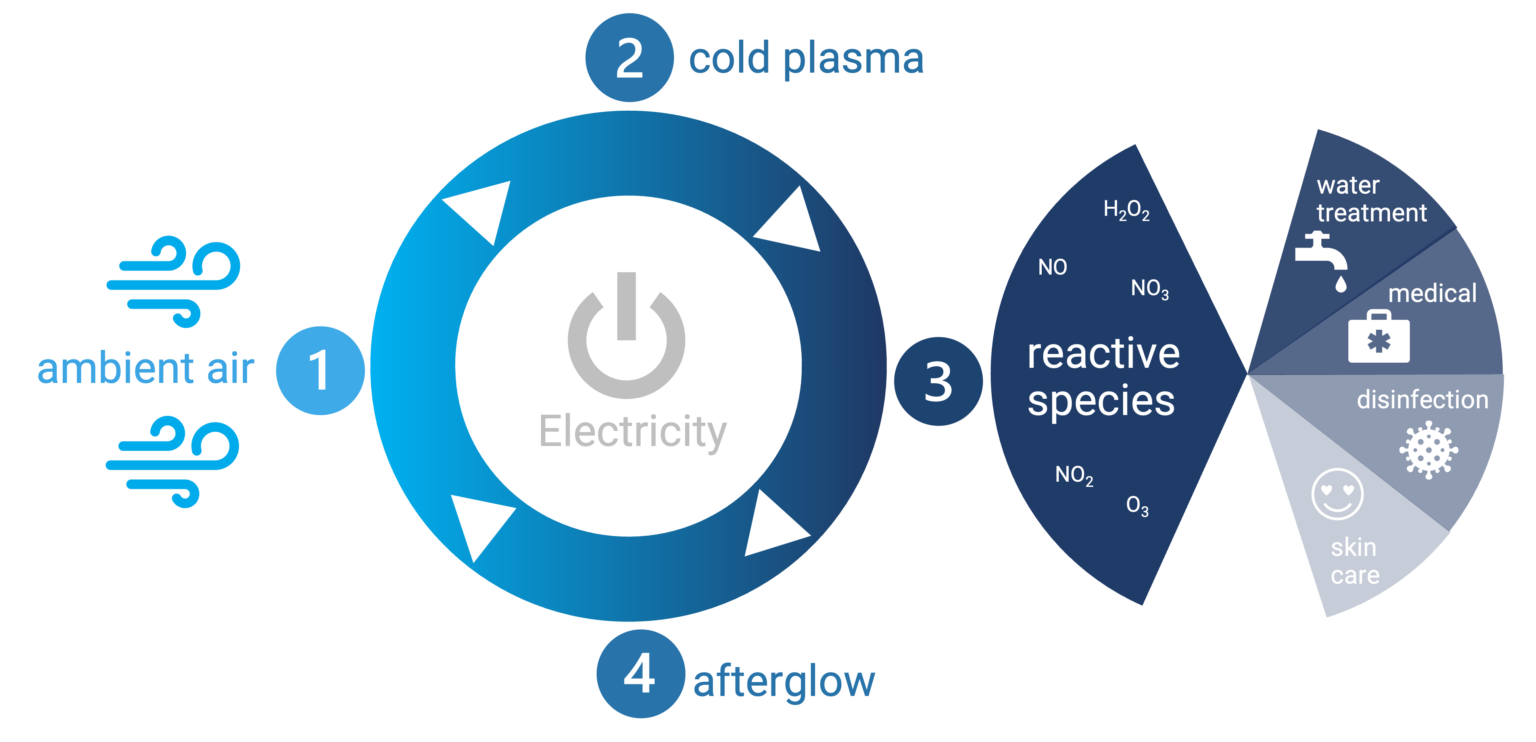




air and energy
there will be plasma
reactive species
afterglow

air and energy
In our technology, the starting point in the circular cold plasma cycle is normal ambient air – we do not need any noble gases to produce cold plasma, which makes our approach particularly inexpensive and uncomplicated. Add some electrical energy to it- and the plasma cycle can begin.

there will be plasma
The desired cold plasma is created on the electrodes through the controlled introduction of energy (high voltage) via the plasma sources (special electrodes). In addition to the design of the plasma source, the precise setting of current and voltage plays a decisive role in determining what type of cold plasma is created (“plasma cocktail”).

reactive species
What happens in cold plasma? Over 600 chemical reactions take place here (with the “ingredients” from the air, including O₂, N₂ and H₂O). For our applications, in addition to the electrons and ions, it is primarily the “reactive species” that make the cold plasma active. By using suitable plasma sources and processes, it is also possible to produce the cold plasma optimized for the different areas of application (water purification, disinfection, medicine, skincare, etc.).

afterglow
Cold plasma is volatile and unstable – if you stop supplying electrical energy in a targeted manner, it only takes a few minutes for the active substances (“reactive species”) to return to normal room air. This process is called afterglow. In the end everything is as before – no waste, no leftovers – a perfect cycle.
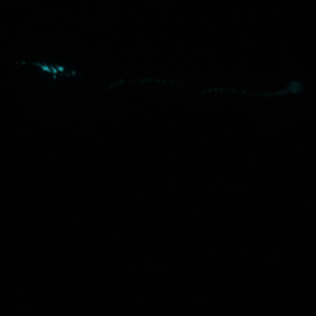
what does cold plasma do to microorganisms?
Cold plasma affects microorganisms at the cellular level through a combination of physical and chemical mechanisms that lead to their inactivation or destruction.
Oxidative stress caused by reactive species: Cold plasma generates reactive oxygen (ROS) and nitrogen species (RNS), including ozone (O₃), hydrogen peroxide (H₂O₂) and hydroxyl radicals (OH). These oxidize essential cell components such as lipids, proteins and DNA. This can destabilize cell membranes, disrupt signaling pathways and ultimately lead to cell death.
DNA damage: Reactive species and UV radiation in plasma produce DNA breaks or modifications to nucleotide bases. This can disrupt replication and gene expression, leading to apoptosis or irreparable loss of function.
Disruption of the cell membrane: Plasma-induced charge carriers and electric fields can destabilize the membrane structure of microorganisms, leading to permeability changes or pore formation. This causes uncontrolled ion exchange and loss of cell homeostasis.
which microorganisms are reduced by cold plasma?
Cold plasma is very powerful, although its ingredients and low energy consumption make it very sustainable. It deactivates a large number of different microorganisms – an excerpt of the tested forms and variants can be found in the graphic below. The best thing about it: none of the microorganisms can develop resistance to the cold plasma – due to the special, combined mode of action of the cold plasma (oxidative stress due to reactive species + DNA damage + disruption of the cell membrane), the microorganisms have no chance even if they mutate – important in times when more and more pathogens are becoming resistant not only to antibiotics, but increasingly also to cleaning and disinfectants.
patents
protected innovation
terraplasma is a leader in the development and application of cold plasma technology. Our patented innovations cover a wide spectrum – from disinfection and odor neutralization to highly specialized plasma sources and monitoring systems. Our protected innovations include:
Surface micro-discharge technology – Innovative design of the plasma source.
Plasma Activated Water (PAW) – A sustainable solution for chemical-free disinfection.
Specialized technologies in the cold plasma sector – from microwave plasma to Venturi and magnetic plasma technology.
Monitoring system – Precise control and monitoring of cold plasma sources.
Freshup – Device for eliminating odors in textiles.
Our patents underline our commitment to technological progress and sustainable solutions. Discover the future of cold plasma technology with terraplasma. More details can be found further down on this page.
Owners: terraplasma GmbH & AprintaPro GmbH
Priority date: 22.08.2022
Patent application: EPOwner: terraplasma GmbH & BSH
Priority date: 18.05.2020
Patent application: International (WO)Owner: terraplasma GmbH
Priority date: 19.11.2019
Patent application: International (WO)Owner: terraplasma GmbH
Priority date: 25.01.2019
Patent Application: EP, US & CNOwner: terraplasma GmbH
Priority date: 15.06.2018
Patent Application: EP
Owner: terraplasma GmbH & terraplasma medical GmbH
Priority date: 15.06.2018
Patent Application: EP, US & JP
Owner: terraplasma GmbH & terraplasma medical GmbH
Priority date: 15.06.2018
Patent Application: EP, US & JP
Owner: terraplasma GmbH
Priority date: 05.02.2016
Patent Application: EU
Patents: US, EP, AT, CH, GB, IRL, IT
Owner: terraplasma GmbH
Priority date: 06.08.2015
Patent Application: EP, CN, CA, MX & KR
Owner: terraplasma GmbH
Priority date: 23.07.2015
Patent Application: JP
Patents: US, CN, EP, CH, GB
Owner: Max-Planck Gesellschaft *
Priority date: 05.05.2011
Patent Application: EU
Patents: US, EP, AT, CH, GB, IRL, IT
* terraplasma GmbH has an exclusive worldwide licenseOwner: Max-Planck Gesellschaft *
Priority date: 25.02.2011
Patents: DE, GB, FR
* terraplasma GmbH has an exclusive worldwide licenseOwner: Max-Planck Gesellschaft *
Priority date: 15.03.2009
Patent Application: CN
Patents: EP, US & JP
* terraplasma GmbH has an exclusive worldwide licenseOwner: Max-Planck Gesellschaft *
Priority date: 15.05.2007
Patents: US, JP, DE, GB, FR
* terraplasma GmbH has an exclusive worldwide licenseOwner: Max-Planck Gesellschaft *
Priority date: 16.09.2005
Patents: US, RU, DE, CH, GB, FR
* terraplasma GmbH has an exclusive worldwide license
